Homemade lasagna is the best. Each layer of this lasagna is thoughtfully composed to balance flavors and textures. The sweet Italian sausage and lean ground beef offer a rich, meaty base, complemented by the subtle sharpness of white onion and the warmth of minced garlic. The cheeses – ricotta, mozzarella, and Parmesan – bring creamy, gooey, and slightly nutty elements, respectively. Fresh herbs like basil and parsley add a burst of freshness, while the subtle spices of fennel seeds, oregano, and nutmeg provide depth. The inclusion of white wine in the sauce not only adds complexity to the flavor but also brings a certain elegance to the dish. And for those who prefer, this can be easily substituted with red wine, chicken, or beef broth, catering to all palates. This lasagna is a celebration of flavors, textures, and aromas that come together in perfect harmony.
Now because this is a from-scratch recipe and because it is so amazing, it requires quite a few steps. We recommend watching the video to get a good idea about how this lasagna is made and assembled. You will also find many of your questions answered below and some great tips for lasagna success. You are going to love this dish, and if you have guests for dinner, you can bet they will ask you for the recipe.
Ingredient Breakdown & Substitutions
Diving into the heart of our lasagna, each ingredient plays a pivotal role in creating the rich, comforting flavors we love. Here’s a detailed breakdown of these key components, along with some versatile substitutions to cater to different tastes and dietary needs.
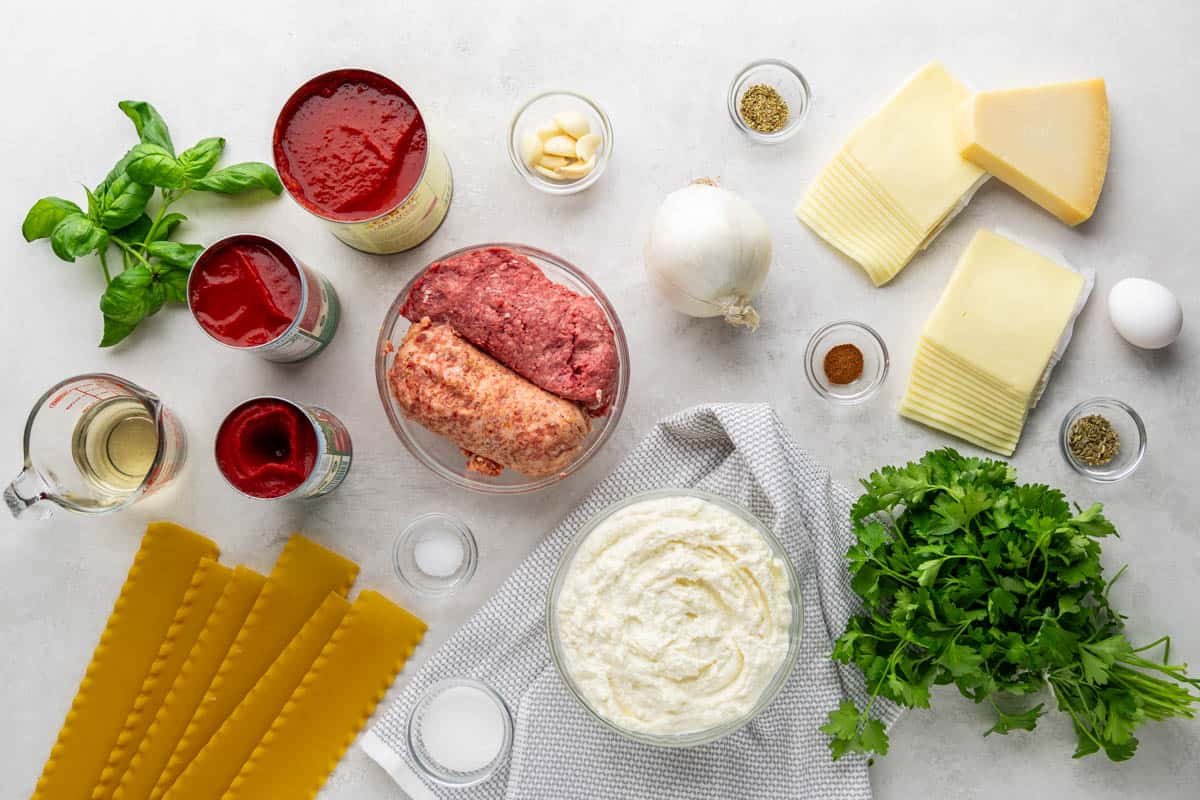
- Sweet Italian Sausage: Offers a mild, herby flavor. Can be substituted with spicy sausage, ground chicken, or a plant-based ground meat alternative.
- Ground Beef: Provides a robust base. Ground turkey or lamb can be used as alternatives. A plant-based ground meat alternative can be used for a vegetarian version.
- Cheeses: Ricotta for creaminess, mozzarella for stretchiness, and Parmesan for a nutty kick. Cottage cheese can replace ricotta, and cheddar can substitute for mozzarella in a pinch.
- Fresh Herbs: Basil and parsley add freshness. Dried herbs can be used in smaller quantities if fresh aren’t available.
- Wine: White wine adds depth, but red wine or broths are excellent substitutes.
Using substitutions can affect final taste and texture.
Frequently Asked Questions
Yes, you can prepare and assemble the lasagna up to 48 hours in advance and refrigerate it before baking.
There are three kinds of cheese in this recipe.
First, the classic lasagna filling of ricotta cheese: Use whole milk ricotta cheese in this recipe for best results.
Second, sliced mozzarella: We like to get our mozzarella sliced at the deli counter in our grocery store. (You want the slices to be pretty thin, 24 slices is the ideal amount and it should equal somewhere around one pound.)
Third, freshly grated (not shredded) Parmesan cheese: Don’t use the canned stuff. It doesn’t melt the same as real, freshly grated Parmesan cheese.
You’ll notice that two cans of tomato paste are used in this recipe. It may seem like a lot, but tomato paste has a super concentrated tomato flavor. By adding in so much, we’re able to get a nice, strong tomato flavor, without adding too much liquid to the sauce.
Pro Tip: If you open the tomato paste cans from both ends, you can use one of the lids to push the paste through the other side of the can, which is easier than scraping it out with a spoon (see how it’s done in the video below).
The blend of herbs included in this bolognese is perfect. The fresh herbs all combine to produce the best flavor, and the key to bringing it all together: fennel seeds. You need the fennel seeds for that authentic, Italian flavor.
Sugar is added to balance the acidity of the tomato. If you prefer to not use sugar, finely chopped carrots are another option, as they are naturally sweet and add another vegetable and flavor to your sauce. Use about a cup in place of the sugar.
Yes. We love the flavor that comes from the fresh herbs, but we know that it isn’t always an option. If you need to use dried herbs, use them in a third of the amount of fresh herbs called for.
The sauce develops flavor as it simmers. It needs to be simmered for a minimum of 1 hour to give you the most amazing lasagna, but you can simmer it up to 4 hours for maximum flavor results. It’s worth every second and doesn’t require much effort at all.
If you don’t want to leave it simmering on the stove, you can always transfer it all to a slow cooker and simmer it in there on high for 4 hours or low for 6 to 8 hours.
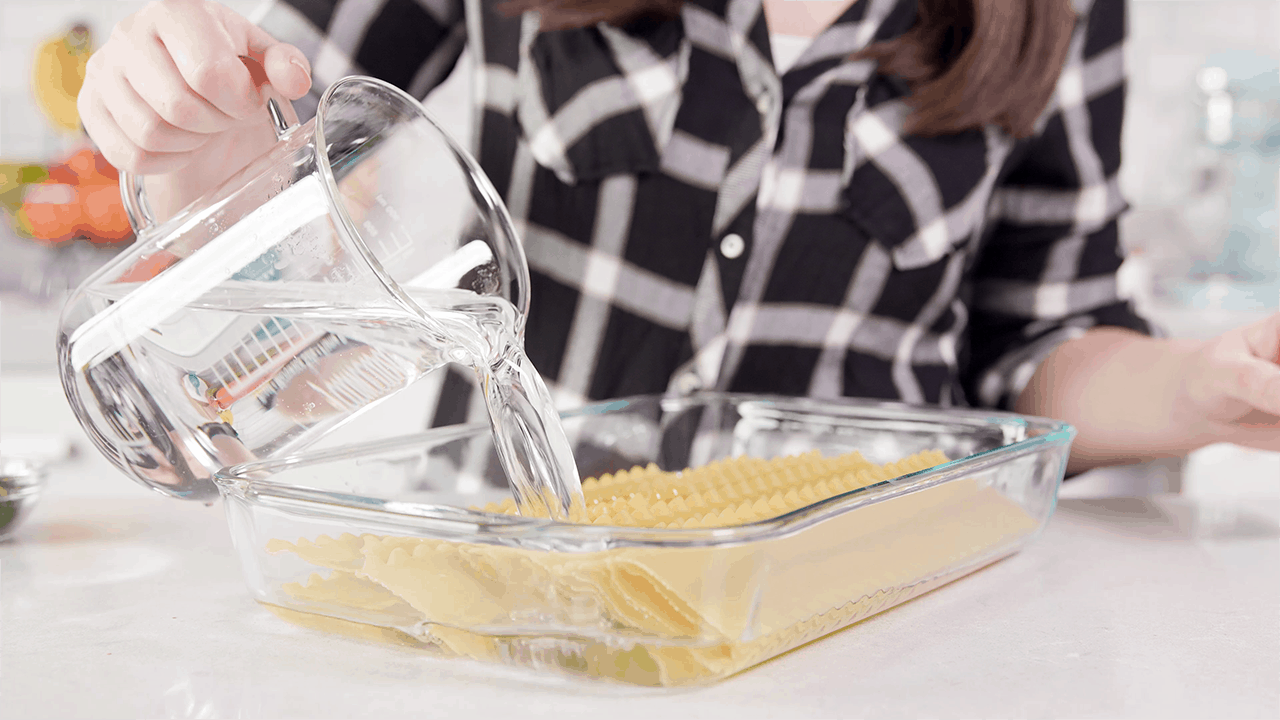
Lasagna Pasta Shortcut: Boiling lasagna noodles is an extra step that we would all love to avoid. No boil lasagna noodles, in our opinion, have an unpleasant texture and often turn out soggy. Here is a hack to skip the boil and make perfect pasta every time: All you have to do is place regular lasagna noodles in a container, like a 9 x 13 pan, and pour hot water over them. Let them soak for 30 minutes and they’ll be tender enough to use in the recipe. Don’t worry, they will finish cooking in the oven.
Visual Guide to Making Bolognese Sauce
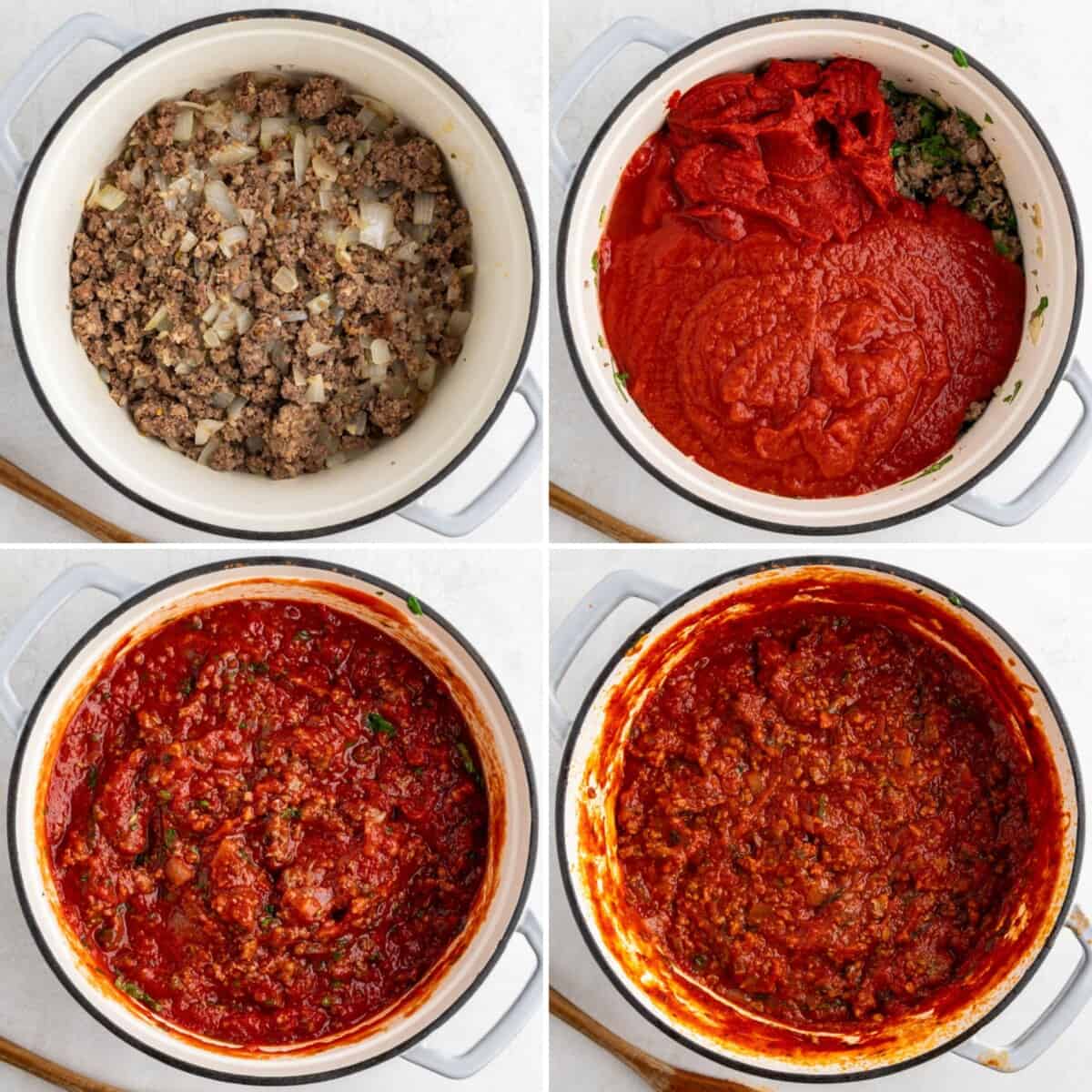
Visual Guide to Assembling the Lasagna
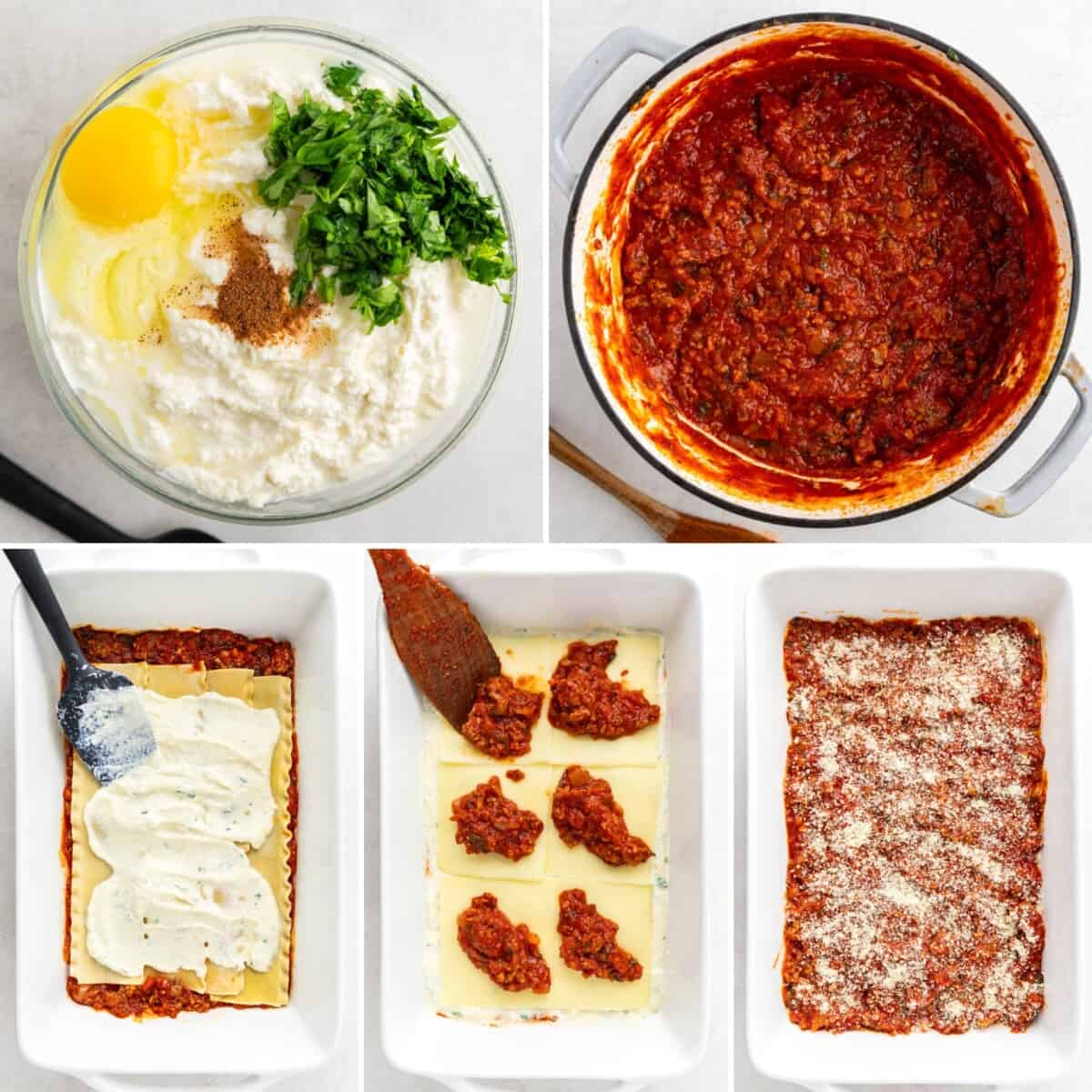
Baking Pan Options
When it comes to baking lasagna, the choice of pan can significantly influence the outcome of your dish. While there are various options available, the most common choices are the standard 9×13 baking pan and a specialized lasagna style pan.
Standard 9×13 Baking Pan
- Size and Shape: The standard 9×13 inch baking pan is a versatile kitchen staple, typically about 2 inches deep. Its rectangular shape is ideal for creating multiple layers without the ingredients spilling over.
- Material Varieties: Available in materials like glass, ceramic, and metal, each offers different heat conduction properties. Metal pans heat up quickly, making them great for achieving a crispy bottom layer, while glass and ceramic provide more even heat distribution.
- Resulting Lasagna: Using this pan size, you’ll get a lasagna that’s thick enough to hold together nicely when served, but not so deep that the top can dry out before the middle is heated through. It’s perfect for standard recipes and serves a good number of portions.
Lasagna Style Pan
- Size and Shape: Lasagna style pans are specifically designed for this dish, often deeper (about 3 inches or more) than standard pans, allowing for more layers.
- Material Varieties: Like standard pans, they come in different materials but are generally metal. The depth is the key feature here, providing ample space for extra layers.
- Resulting Lasagna: Ideal for those who prefer a thicker, heartier lasagna with numerous layers. The extra depth ensures that the lasagna cooks evenly throughout, and the layers are less likely to dry out. However, it’s important to adjust cooking times accordingly due to the increased thickness.
While both the standard 9×13 baking pan and the deeper lasagna style pan have their unique advantages, we recommend using a lasagna pan for its added depth and capacity.
Serving Suggestions
To turn your lasagna into a complete and satisfying meal, consider these classic pairings:
- Garlic Bread: Serve your lasagna with a side of warm, buttery garlic bread. The crispiness of the bread complements the soft layers of lasagna, and it’s perfect for mopping up any leftover sauce on the plate.
- Fresh Salad: Balance the richness of the lasagna with a light, refreshing salad. A simple mixed greens salad or a classic Caesar salad adds a crisp, fresh element to your meal, offering a contrast in flavors and textures.
- Tiramisu: Conclude your meal with a serving of tiramisu. This classic Italian dessert, with its layers of coffee-soaked ladyfingers and mascarpone cheese, offers a sweet and indulgent end to your dining experience.
Troubleshooting
- Soggy Noodles: Ensure noodles are only soaked as instructed, not cooked, to avoid sogginess.
- Dry Lasagna: Covering with foil during the initial baking helps retain moisture. Also, ensure ample sauce in each layer.
- Not Cooking Evenly: Allow the lasagna to reach room temperature before baking if it was refrigerated.
Tips From the Chef
- Let the lasagna rest for 15 minutes after baking for easier slicing.
- Use a deep pan to prevent overflow.
- Bake until the cheese is golden for the best flavor.
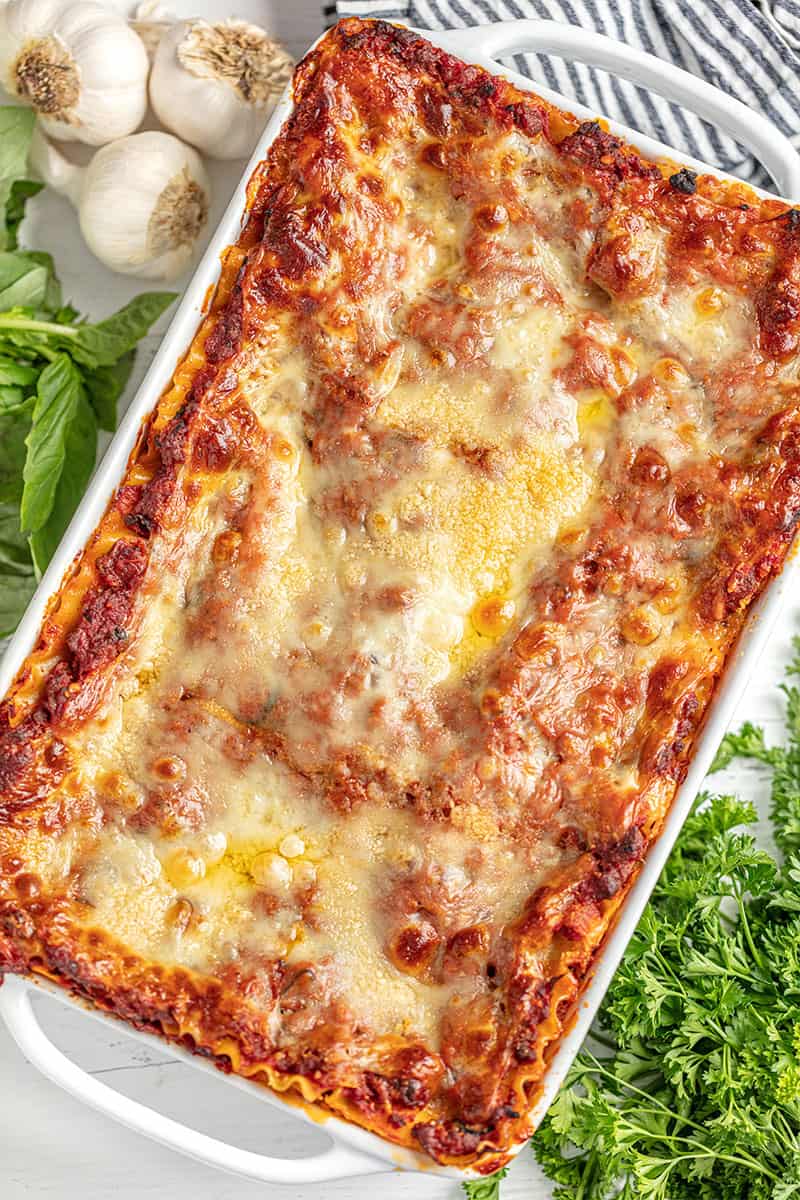
Storage, Freezer & Reheating Instructions
Leftover lasagna can be stored in the refrigerator for up to 5 days. Reheat in the oven or microwave until warmed through.
Preparing Lasagna for Freezing
- Cooling: Allow your cooked lasagna to cool to room temperature. Freezing it while hot can lead to condensation, resulting in a soggy texture upon reheating.
- Portioning: Consider cutting the lasagna into individual portions. This makes it easier to thaw and reheat only what you need, reducing waste.
- Wrapping: Wrap each portion tightly with plastic wrap, ensuring that it’s sealed well to prevent freezer burn. Then, wrap it again with aluminum foil for added protection.
- Labeling: Label each portion with the date. Lasagna can be stored in the freezer for up to 3 months.
Freezing Unbaked Lasagna
- Assembly: If you prefer to freeze an unbaked lasagna, assemble it as per the recipe but skip the baking step.
- Container: Use a freezer-safe dish or disposable aluminum tray for easy storage and baking.
- Covering: Cover the assembled lasagna tightly with both plastic wrap and aluminum foil.
- Freezing: Freeze immediately. Unbaked lasagna can be stored in the freezer for up to 3 months.
Thawing and Reheating Frozen Lasagna
- Thawing: Transfer the frozen lasagna to the refrigerator for at least 24 hours to thaw slowly. This ensures even reheating and maintains the texture.
- Reheating Baked Lasagna: Preheat the oven to 375°F. Remove the plastic wrap and cover the lasagna with foil. Bake for about 30 minutes (longer if still partially frozen), then uncover and bake for another 10-15 minutes or until hot and bubbly.
- Baking Unbaked Lasagna: For unbaked lasagna, keep the foil on and bake it at 375°F for about 60 minutes, then uncover and continue baking for an additional 15-20 minutes or until the top is golden and the lasagna is heated through.
More Lasagna Recipes
Watch the video below where Rachel will walk you through every step of this recipe. Sometimes it helps to have a visual, and we’ve always got you covered with our cooking show. You can find the complete collection of recipes on YouTube, Facebook Watch, or our Facebook Page, or right here on our website with their corresponding recipes.
Trending Products

GE Electronic Window Air Conditioner 6000 BTU, Efficient Cooling for Smaller Areas Like Bedrooms and Guest Rooms, 6K BTU Window AC Unit with Easy Install Kit, White

Alen BreatheSmart Classic H13 HEPA Air Purifier, Air Purifiers For Home Large Room w/ 1100 SqFt Coverage, Medical-Grade Air Cleaner for Pet Dander & Odor, up to 12 Mos. Filter Life, Espresso

Luminance Midway Eco LED Ceiling Fan with Light and Remote | Dimmable 54 Inch Fixture with DC Motor | Contemporary 5 Blade Design with Downrod Mount for Hanging, Appliance White

Nostalgia RF6RRAQ Retro 6-Can Personal Cooling and Heating Mini Refrigerator with Carry Handle for Home Office, Car, Boat or Dorm Room-Includes AC/DC Power Cords,,1 cubic feet, Aqua











